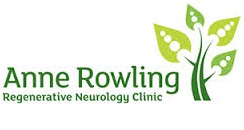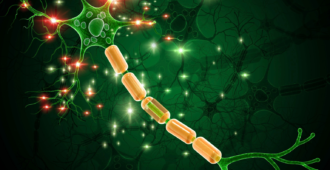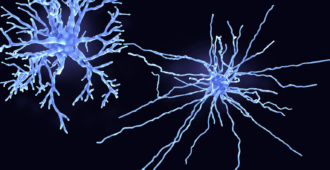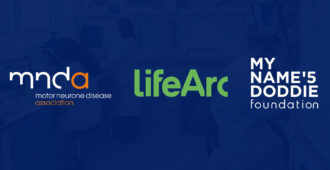The sun was (uncharacteristically!) shining on Edinburgh last week for a symposium to celebrate the launch of the new Anne Rowling Regenerative Neurology Clinic. The clinic, which opened to patients earlier this year, was founded following a donation by the author JK Rowling, in memory of her mother, who died from complications related to multiple sclerosis (MS). Run by Professors Siddarthan Chandran and Charles ffench-Constant, the clinic aims to translate laboratory research into clinical trials for neurodegenerative diseases such as MS and MND.
The programme for the two-day meeting was packed with ‘big hitters’ from the world of neurology. In keeping with the regenerative neurology theme, the opening session was chaired by Sir John Gurdon, recent co-winner of the Nobel Prize for physiology and Medicine, whose pioneering work on cell cloning set the foundations for the more recent development of induced pluripotential stem cells, which are currently revolutionising medical research.
Different diseases, common challenges
The first day was given over to research areas such as multiple sclerosis, Parkinson’s disease and Alzheimer’s disease, as well as spinal injury and pain. What was also apparent is that different fields of neurology are wrestling with similar challenges: to diagnose disease earlier, ideally even before symptoms occur; to find biomarkers that tell us about the changes occurring in the Central Nervous System(CNS) at different stages of disease; to really understand the order in which these different aspects of pathology (the study and diagnosis of disease) occur and, given the theme of the conference, to sift the cellular changes caused by disease from the body’s attempts at cellular repair. All of these feed into the greatest challenge – how to take this accumulated knowledge from bench to bedside.
We can learn a lot from diseases that are further ahead in this process, such as the excellent overview by Prof Alastair Compston (Cambridge) on MS. It’s becoming clear that MS has distinct disease stages, starting off as an inflammatory disease, but progressing to a more ‘traditional’ neurodegenerative disease in more advanced stages. Whist there has been some considerable success in treating the former, the approaches to the latter have, as with MND, met with very limited success.
The use of imaging techniques to work out what is happening within the brain has been a vital factor in drug development for MS. As Prof David Miller (University College London) pointed out, magnetic resonance imaging (MRI) can pick up positive changes in small MS drug trials that are not large enough to show changes in disability. This sort of biomarker-based evidence gives drug companies the confidence to invest in the larger, much more expensive trials needed to show a clinical effect.
A presentation on the imaging of pain by Prof Irene Tracey (Oxford) provided a fascinating insight into the power of the placebo effect. She explained how neuroimaging has helped researchers to identify the brain regions associated with placebo effects and also gave examples of studies where the placebo effect has performed as well as (and even outperformed) commonly used painkillers! The power of placebo can be very strong indeed and it is important to always ensure that trials are rigorously performed to account for this.
Parkinson’s disease has always been viewed as a promising candidate for cell transplantation therapy, but clinical studies over the past 30 years have produced mixed results. Profs Roger Barker (Cambridge) and Anders Bjorklund (Lund University) discussed the various reasons for this ‘heterogeneity of response’ and how these are being addressed in the plans for a pan-European study.
In terms of cell transplantation, the approaches that will need to be taken for MND are very different from those for Parkinson’s disease. In Parkinson’s disease the strategy is to try and replace some of the key neurons that have died, but due to the immense length of human motor neurons, such a strategy of rewiring the nervous system is highly unlikely to work for MND. However, there are other approaches that can be taken, as Prof Clive Svendsen (Cedars-Sinai Medical Center) explained.
His approach involves a combination of gene therapy and stem cell therapy. By converting human stem cells into astrocytes, which are cells known to play an important role in keeping neurons healthy. By genetically modifying these cells to produce large quantities of a nerve protecting factor called glial-derived neurotrophic factor, and injecting them into the spinal cord of SOD1 rats, he has shown that the surviving motor neurons can be protected. He is in the process of gearing up for a phase 1 therapeutic trial in up to 18 carefully selected MND patients.
Disease in the dish
Prof Svendsen also briefly spoke about the promising research arising from the use of induced pluripotential stem cells (iPSCs) to study MND – a topic taken up in much more detail by Prof Jeff Rothstein (Johns Hopkins University) who highlighted recent advances in understanding the C9orf72 form of the disease.
It may be possible to create specially tailored gene therapy approaches for some forms of familial (inherited) MND, as is currently being attempted in SOD1 MND. Prof Rothstein’s initial work using iPSC-derived motor neurons suggests that this approach is also worth considering for the more common C9orf72 from as well.
Prof Steve Finkbeiner (University of California) who is collaborating in the Association-funded international stem cell initiative elaborated on the use of iPSCs as a tool for drug discovery, demonstrating how fully-automated robot-based systems can be used to follow the fate of thousands of individual human motor neurons in the dish over a prolonged time period. The great thing about robots is that they don’t need sleep, so can analyse the cells at all times of day and night. They do, however, have Twitter accounts, so they can report in to the centre staff when they have completed their experiments!
One of the exiting prospects of using these automated systems is the potential to screen thousands of compounds. If human motor neurons can be protected in the dish, there are no guarantees, but it at least shortens the odds that the human motor neurons can be protected in the human as well. There are still many improvements that can be made to the process, but screening work is underway, with a particular focus on drugs that stimulate cellular process called autophagy (a process in which a cell breaks down damaged components), which is believed to be protective across a number of neurodegenerative diseases.
There were many take home messages from this meeting, but what was abundantly clear from all the work presented was the enthusiasm of each speaker for their field of research and an optimism that we are on the cusp of major advances in understanding neurological conditions. Sharing of new knowledge across the various diseases and disciplines can only bring those advances closer.







So many ideas but not one to help my dad who is willing to do trial tests .please offer him at least one glimps of hope x
Dear Wendy,
I am glad that you feel there are lots of good ideas but sorry that you feel that way as your dad is willing to take part in trials.
Unfortunately there are no MND clinical drug trials recruiting in the UK at present, however we are aware of a phase III clinical trial of NP001 in America later this year (we are unsure at the moment whether this will include the UK). As you can see there is a lot going on in MND research and major advances have happened in the past couple of years that will inevitably lead to more clinical trials in the future.
If your dad wishes to take part in MND research there are many ways he can get involved other than clinical trials. However, if your dad wishes to be involved in future clinical trials he can join the ‘research register’. This register compiles a list of people wishing to take part in research and when a trial or research opportunity arises those on this register are contacted. If your dad is interested in this he can find out more on our website: http://www.mndassociation.org/research/MND+research+and+you/Get+involved+in+research/register-your-interest-to-get-involved-with-mnd-research
We have a number of other research opportunities including an ‘Epidemiology study’ which helps answer the ‘why me?’ question by looking at environmental, lifestyle and genetic factors (at Birmingham, Sheffield and King’s London MND care centres). We also have a diaphragm pacing clinical trial for people living with MND who develop breathing difficulties (Sheffield, Oxford, Newcastle-upon-Tyne, Manchester, Plymouth, Leeds and Royal Free Hospital London). Another way people can leave an everlasting gift for research is tissue donation and details of this and the above research opportunities are all available on the taking part in research pages of our website:
http://www.mndassociation.org/takepartinresearch
If you have any questions about MND research please do not hesitate to contact me via research@mndassociation.org or 01604 611 880
Kindest regards,
Samantha
Research Development Team
Motor Neurone Disease Association
PO Box 246, Northampton, NN1 2PR, UK